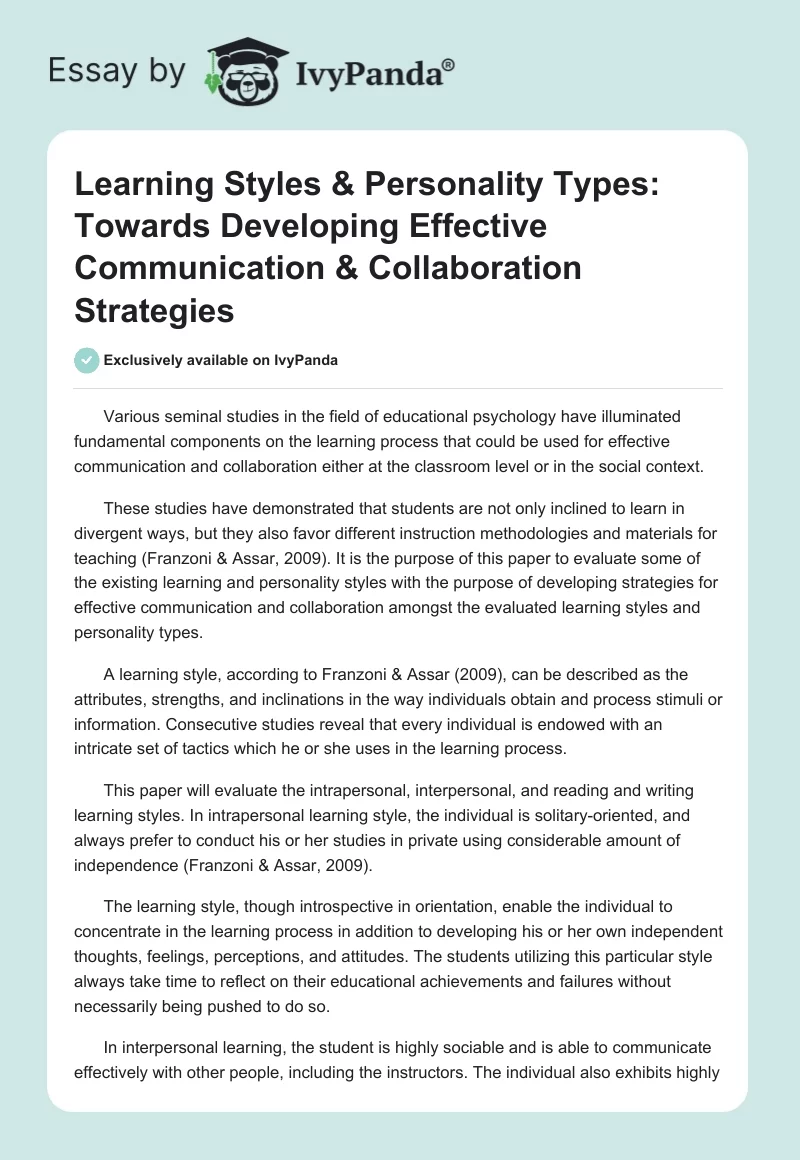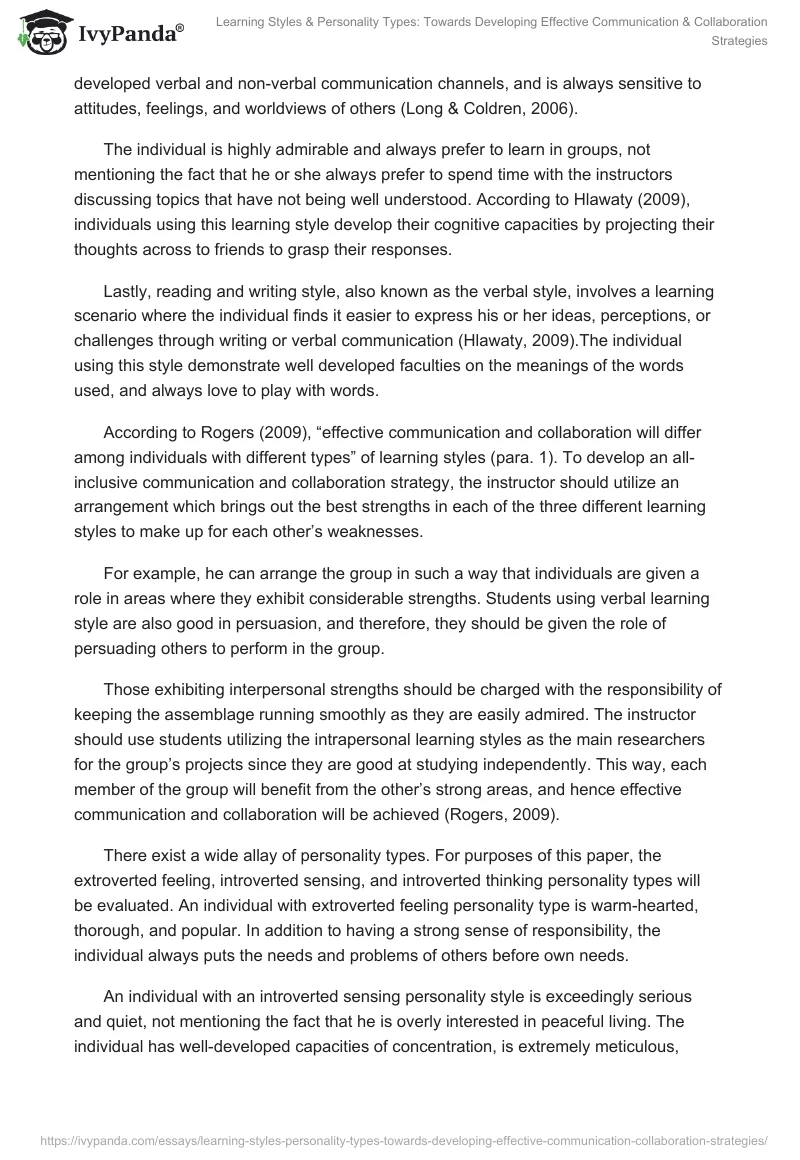Various seminal studies in the field of educational psychology have illuminated fundamental components on the learning process that could be used for effective communication and collaboration either at the classroom level or in the social context.
These studies have demonstrated that students are not only inclined to learn in divergent ways, but they also favor different instruction methodologies and materials for teaching (Franzoni & Assar, 2009). It is the purpose of this paper to evaluate some of the existing learning and personality styles with the purpose of developing strategies for effective communication and collaboration amongst the evaluated learning styles and personality types.
A learning style, according to Franzoni & Assar (2009), can be described as the attributes, strengths, and inclinations in the way individuals obtain and process stimuli or information. Consecutive studies reveal that every individual is endowed with an intricate set of tactics which he or she uses in the learning process.
This paper will evaluate the intrapersonal, interpersonal, and reading and writing learning styles. In intrapersonal learning style, the individual is solitary-oriented, and always prefer to conduct his or her studies in private using considerable amount of independence (Franzoni & Assar, 2009).
The learning style, though introspective in orientation, enable the individual to concentrate in the learning process in addition to developing his or her own independent thoughts, feelings, perceptions, and attitudes. The students utilizing this particular style always take time to reflect on their educational achievements and failures without necessarily being pushed to do so.
In interpersonal learning, the student is highly sociable and is able to communicate effectively with other people, including the instructors. The individual also exhibits highly developed verbal and non-verbal communication channels, and is always sensitive to attitudes, feelings, and worldviews of others (Long & Coldren, 2006).
The individual is highly admirable and always prefer to learn in groups, not mentioning the fact that he or she always prefer to spend time with the instructors discussing topics that have not being well understood. According to Hlawaty (2009), individuals using this learning style develop their cognitive capacities by projecting their thoughts across to friends to grasp their responses.
Lastly, reading and writing style, also known as the verbal style, involves a learning scenario where the individual finds it easier to express his or her ideas, perceptions, or challenges through writing or verbal communication (Hlawaty, 2009).The individual using this style demonstrate well developed faculties on the meanings of the words used, and always love to play with words.
According to Rogers (2009), “effective communication and collaboration will differ among individuals with different types” of learning styles (para. 1). To develop an all-inclusive communication and collaboration strategy, the instructor should utilize an arrangement which brings out the best strengths in each of the three different learning styles to make up for each other’s weaknesses.
For example, he can arrange the group in such a way that individuals are given a role in areas where they exhibit considerable strengths. Students using verbal learning style are also good in persuasion, and therefore, they should be given the role of persuading others to perform in the group.
Those exhibiting interpersonal strengths should be charged with the responsibility of keeping the assemblage running smoothly as they are easily admired. The instructor should use students utilizing the intrapersonal learning styles as the main researchers for the group’s projects since they are good at studying independently. This way, each member of the group will benefit from the other’s strong areas, and hence effective communication and collaboration will be achieved (Rogers, 2009).
There exist a wide allay of personality types. For purposes of this paper, the extroverted feeling, introverted sensing, and introverted thinking personality types will be evaluated. An individual with extroverted feeling personality type is warm-hearted, thorough, and popular. In addition to having a strong sense of responsibility, the individual always puts the needs and problems of others before own needs.
An individual with an introverted sensing personality style is exceedingly serious and quiet, not mentioning the fact that he is overly interested in peaceful living. The individual has well-developed capacities of concentration, is extremely meticulous, responsible, accountable, and dependable. In addition, such an individual is well-organized and work very hard towards the realization of set objectives.
Finally, an individual with introverted thinking personality type is quiet, restrained, and is always interested in understanding how and why items work the way they do. Such an individual may exhibit risk-taking behaviors in finding elucidations to practical challenges, and are very loyal to their peers. They are extremely detached and analytical (BSM Consulting, 2006).
It is easy to develop an effective communication and collaboration strategy for individuals with such personality traits since they share several things in common. First, they have a deep sense of responsibility, which should be used to move the affairs of the group forward. The individuals with extroverted feeling personality type should be selected to lead the group due to their warm-hearted and popular nature. This will go a long way to compensate for the quiet and reserved nature demonstrated by the other members.
Tasks requiring concentration and seriousness should be allocated to the individuals with introverted sensing personality traits, while tasks requiring a considerable degree of innovativeness and independence of thought can be successfully handled by individuals with introverted thinking personality type. Such a communication and collaboration strategy will be strengthened by the fact that all individuals exhibit efficient organization capacities (BSM Consulting, 2006; Rogers, 2006).
Reference List
BSM Consulting. (2006). High-level description of the sixteen personality types. Web.
Franzoni, A.L., & Assar, S. (2009). Student learning styles: Adaptation method based on teaching strategies and electronic media. Journal of Educational Technology & Society, Vol. 12, Issue 4, p. 15-29. Web.
Hlawaty, H. (2009). Learning and learning styles. European Education, Vol. 40, Issue 4, p. 23-45. Web.
Long, H.E., & Coldren, T. (2006). Interpersonal influences in large lecture-based classes. College Teaching, Vol. 54, Issue 2, P. 237-243. Web.
Rogers, S. (2009). Communication and Collaboration Styles. Web.


